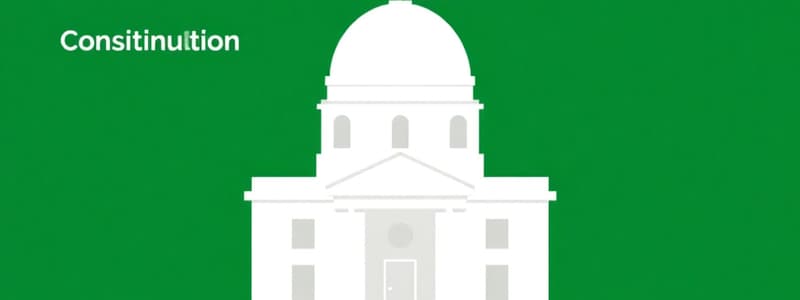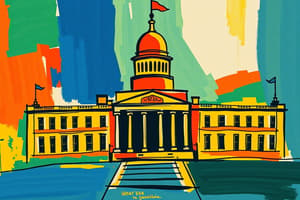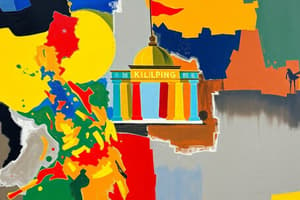Podcast
Questions and Answers
How does a constitution define the relationship between the state and its people?
How does a constitution define the relationship between the state and its people?
By establishing the basic structure of the political system under which the people are to be governed.
What are the key features that define a 'State' according to the provided context?
What are the key features that define a 'State' according to the provided context?
A defined territory, an organized government, and the power to make domestic and foreign policies.
What role did the Objective Resolution play in shaping the Indian Constitution, and when was it adopted?
What role did the Objective Resolution play in shaping the Indian Constitution, and when was it adopted?
It laid down the fundamentals and philosophy of the constitutional structure and was adopted on January 22, 1947.
Outline two primary functions that a constitution serves in governing a society.
Outline two primary functions that a constitution serves in governing a society.
How did the Independence Act of 1947 alter the status and functions of the Constituent Assembly?
How did the Independence Act of 1947 alter the status and functions of the Constituent Assembly?
Why is a Constitution considered a 'living document?'
Why is a Constitution considered a 'living document?'
Name the offer that proposed setting up an Indian body to frame the constitution after the war, and in what year was it made?
Name the offer that proposed setting up an Indian body to frame the constitution after the war, and in what year was it made?
Explain the composition of the Constituent Assembly based on the Cabinet Mission Proposal.
Explain the composition of the Constituent Assembly based on the Cabinet Mission Proposal.
Who served as the temporary President of the Constituent Assembly, and what practice was followed in their election?
Who served as the temporary President of the Constituent Assembly, and what practice was followed in their election?
Besides drafting the constitution, what crucial tasks did the Constituent Assembly accomplish?
Besides drafting the constitution, what crucial tasks did the Constituent Assembly accomplish?
How long did it take for the Constituent Assembly to complete the Constitution?
How long did it take for the Constituent Assembly to complete the Constitution?
Which committee was responsible for creating the first draft of the Indian Constitution?
Which committee was responsible for creating the first draft of the Indian Constitution?
When was the Indian Constitution adopted and enacted?
When was the Indian Constitution adopted and enacted?
What is the significance of January 26 in the context of the Indian Constitution?
What is the significance of January 26 in the context of the Indian Constitution?
How does the Indian Constitution define a 'State'?
How does the Indian Constitution define a 'State'?
Name the three types of Constitutions.
Name the three types of Constitutions.
Contrast a unitary and a federal constitution.
Contrast a unitary and a federal constitution.
Describe the concept of 'Constitutional Government' as it relates to the supremacy of the Constitution.
Describe the concept of 'Constitutional Government' as it relates to the supremacy of the Constitution.
Define 'Constitutionalism' in terms of limited governance and the rule of law.
Define 'Constitutionalism' in terms of limited governance and the rule of law.
As per the Supreme Court's observation in Rameshwar Prasad v. Union of India, what does constitutionalism abhor?
As per the Supreme Court's observation in Rameshwar Prasad v. Union of India, what does constitutionalism abhor?
What key idea was emphasized in S R Chaudhari Vs State of Punjab (2001) regarding constitutionalism?
What key idea was emphasized in S R Chaudhari Vs State of Punjab (2001) regarding constitutionalism?
What does 'Constitutional Morality' (CM) mean in the context of adhering to the core principles of the constitution?
What does 'Constitutional Morality' (CM) mean in the context of adhering to the core principles of the constitution?
What is the relevance of the Naz Foundation case 2009 in context of constitutional morality?
What is the relevance of the Naz Foundation case 2009 in context of constitutional morality?
What is the relevance of the Lt Governor of Delhi case 2016 in context of constitutional morality?
What is the relevance of the Lt Governor of Delhi case 2016 in context of constitutional morality?
What is the relevance of the Navtej Singh Johar v. Union of India 2018 case in context of constitutional morality?
What is the relevance of the Navtej Singh Johar v. Union of India 2018 case in context of constitutional morality?
What is the relevance of the Sabarimala Case 2018 in context of constitutional morality?
What is the relevance of the Sabarimala Case 2018 in context of constitutional morality?
What distinguishes a rigid constitution from a flexible one?
What distinguishes a rigid constitution from a flexible one?
What conditions are necessary to retain constitutionalism in a country?
What conditions are necessary to retain constitutionalism in a country?
Define the term 'Constitution'.
Define the term 'Constitution'.
Describe the role of a Constitution in limiting governmental power and empowering its citizens?
Describe the role of a Constitution in limiting governmental power and empowering its citizens?
Identify the year when M.N. Roy gave the idea for constituent assembly?
Identify the year when M.N. Roy gave the idea for constituent assembly?
Identify the year when the Cabinet Mission was proposed.
Identify the year when the Cabinet Mission was proposed.
How was the Constituent Assembly elected?
How was the Constituent Assembly elected?
Who was the President of the Constituent body?
Who was the President of the Constituent body?
Who was the head of the Drafting Committee?
Who was the head of the Drafting Committee?
When was the final session of constituent assembly held?
When was the final session of constituent assembly held?
Name any two major committees each Chaired by Jawaharlal Nehru and Dr. Rajendra Prasad in the Constituent Assembly
Name any two major committees each Chaired by Jawaharlal Nehru and Dr. Rajendra Prasad in the Constituent Assembly
Describe role of a rigid and flexible constitution?
Describe role of a rigid and flexible constitution?
What does the phrase "no absolutism" reflect about the arrangement of the State in Constitutional Government?
What does the phrase "no absolutism" reflect about the arrangement of the State in Constitutional Government?
Briefly describe two key principles of constitutionalism.
Briefly describe two key principles of constitutionalism.
Flashcards
What is a Constitution?
What is a Constitution?
A country's basic political structure under which people are governed.
What are the constitution's main roles?
What are the constitution's main roles?
It establishes Legislature, Executive and Judiciary; defines their powers and regulates their relationships.
What is a function of a Constitution?
What is a function of a Constitution?
A set of basic rules for societal coordination.
Decision-Making Power
Decision-Making Power
Signup and view all the flashcards
Limits on Government
Limits on Government
Signup and view all the flashcards
Role of state?
Role of state?
Signup and view all the flashcards
Constitution and National Identity
Constitution and National Identity
Signup and view all the flashcards
August Offer
August Offer
Signup and view all the flashcards
Cabinet Mission Proposal
Cabinet Mission Proposal
Signup and view all the flashcards
First President of the Assembly
First President of the Assembly
Signup and view all the flashcards
Objective Resolution
Objective Resolution
Signup and view all the flashcards
Changes by Independence Act, 1947
Changes by Independence Act, 1947
Signup and view all the flashcards
Constitution's Initial Contents
Constitution's Initial Contents
Signup and view all the flashcards
What is a State?
What is a State?
Signup and view all the flashcards
Constitutional government
Constitutional government
Signup and view all the flashcards
Constitutionalism
Constitutionalism
Signup and view all the flashcards
Constitutional Morality
Constitutional Morality
Signup and view all the flashcards
Study Notes
What is a Constitution?
- It establishes the fundamental structure of a political system.
- It defines the powers, responsibilities, and relationships among the legislature, executive, and judiciary.
- It is the supreme law and a continuously evolving document.
Functions of a Constitution
- Provides basic rules for societal coordination.
- Determines the decision-making authority within a society, shaping the government's structure.
- Defines the limits on government power over citizens.
- Enables the government to meet societal aspirations and foster justice.
- Expresses the fundamental identity of a people.
Demand for a Constituent Assembly
- 1934: M.N. Roy proposed the idea of a constituent assembly.
- 1935: The Indian National Congress (INC) officially demanded a constituent assembly.
- 1940: August Offer proposed setting up a representative Indian body after the war to frame a constitution.
- 1942: Cripps Mission attempted to address the constitution-making issue.
- 1946: Cabinet Mission occurred.
Composition of the Constituent Assembly Based on the Cabinet Mission Proposal
- Total Strength: 389 members, allocated at 1 seat per 1 million population.
- Seat Allocation: Divided into British Provinces with 3 categories and Princely States.
- British Provinces: Seats divided among Muslims, Sikhs, and General categories.
- Election Process: Representatives from each community were elected by members of their community in the provincial legislative assembly.
- Structure: Was designed to be partly elected and partly nominated.
- British Provinces: Partly elected representatives.
- Princely States: Partly nominated representatives.
Working of the Constituent Assembly
- First meeting: December 9, 1946.
- Temporary President: Dr. Sachchidananda Sinha, the oldest member, was elected as the temporary President, following French practice.
- President: Later, Dr. Rajendra Prasad became President.
- Vice-Presidents: H.C. Mukherjee and V.T. Krishnamachari were elected.
Objective Resolution
- Moved by Jawaharlal Nehru on December 13, 1946.
- Established the constitutional structure's fundamentals and philosophy.
- Declared India as an Independent Sovereign Republic.
- Autonomous Units: Territories will retain the status of autonomous units with residuary powers.
- Authority: All power is derived from the people.
- Adoption: Unanimously adopted on January 22, 1947.
- Influence: Its modified version forms the Preamble of the current Constitution.
Changes Made by the Independence Act, 1947
- Sovereign Body: The Assembly became a fully sovereign body.
- Legislative Body: It also became a legislative body.
- First Parliament: Became the first Parliament of free India, known as the Dominion Legislature.
- Constituent Body Chair: Dr. Rajendra Prasad chaired.
- Legislative Body Chair: G.V. Mavlankar chaired.
- Dual Functions: These two functions continued until November 26, 1949.
- Total Strength: The Assembly's total strength was 299 (229+70).
Other Functions Performed
- May 1949: Membership of the Commonwealth was ratified.
- July 22, 1947: The national flag was adopted.
- January 24, 1950: The national anthem and the national song were adopted.
- January 24, 1950: Dr. Rajendra Prasad was elected as the first President of India.
Important Facts
- Sessions: There were a total of 11 sessions.
- Duration: The constitution was created in 2 years, 11 months, and 18 days.
- Final Session: The final session was on January 24, 1950.
- Provisional Parliament: It continued as the provisional parliament of India from January 26, 1950, until the new Parliament was formed after the 1951–52 elections.
Major Committees of the Constituent Assembly
- Union Powers Committee: Jawaharlal Nehru
- Union Constitution Committee: Jawaharlal Nehru
- Provincial Constitution Committee: Sardar Patel
- Drafting Committee: Dr. B.R. Ambedkar
- Advisory Committee on Fundamental Rights, Minorities and Tribal and Excluded Areas: Sardar Patel
- Rules of Procedure Committee: Dr. Rajendra Prasad
- States Committee (Committee for Negotiating with States): Jawaharlal Nehru
- Steering Committee: Dr. Rajendra Prasad
Drafting Committee
- Setup: Established on August 29, 1947.
- Chairman: Dr. B.R. Ambedkar.
- Members: N. Gopalaswamy Ayyangar, Alladi Krishnaswamy Ayyar, Dr. K.M. Munshi, Syed Mohammad Saadullah.
- Replacements: N. Madhava Rau replaced B.L. Mitter (who resigned due to ill-health), and T.T. Krishnamachari replaced D.P. Khaitan (who died in 1948).
Enactment of the Constitution
- Adoption: The Constituent Assembly adopted, enacted, and gave the Constitution to themselves on November 26, 1949.
- Content: The adopted Constitution included a Preamble, 395 Articles, and 8 Schedules.
- Key Figure: Dr. B.R. Ambedkar is known as the "Father of the Indian Constitution" and 'Modern Manu, Chief Architect Of The Constitution Of India.
Enforcement of the Constitution
- Key Date: A major part of the Constitution came into force on January 26, 1950.
- Historical Significance: January 26 was chosen because Purna Swaraj day was celebrated on this day in 1930, following the Lahore Session resolution in December 1929.
Definition of State
- Defined as a political association occupying a definite territory with an organized government that possesses the power to make domestic and foreign policies.
Types of Constitution
- Written and Unwritten
- Rigid and Flexible
- Unitary and Federal
Constitutional Government
- Defined as a state arrangement where the Constitution is considered supreme, with no absolutism.
Constitutionalism
- A polity governed by a constitution that ordains limited government and the rule of law, as opposed to arbitrary and authoritarian rule.
- It includes separation of powers, responsible and accountable government, popular sovereignty, rule of law, an independent judiciary, individual rights, civilian control of the military, and police accountability.
- The Supreme Court recognized constitutionalism as a system of government that rejects absolutism and is based on objectivity provided by the Constitution itself in the case of Rameshwar Prasad v. Union of India, 2006.
- A constitution alone does not guarantee constitutionalism; primacy to democratic policies and individual rights must be given, as noted in S R Chaudhari Vs State of Punjab (2001).
Constitutional Morality
- Not explicitly defined but means adhering to the core principles of the constitution in a democracy.
- It involves being morally obligated to uphold constitutional values with dignity, faithfulness, and without compromise.
- Key elements include rule of law, freedom of choice and expression, social justice, due process of law, individual liberty, the right to equality, and the Preamble.
- Key Cases: Naz Foundation case 2009, Lt Governor of Delhi case 2016, Navtej Singh Johar v. Union of India 2018, Sabarimala Case 2018.
Studying That Suits You
Use AI to generate personalized quizzes and flashcards to suit your learning preferences.




